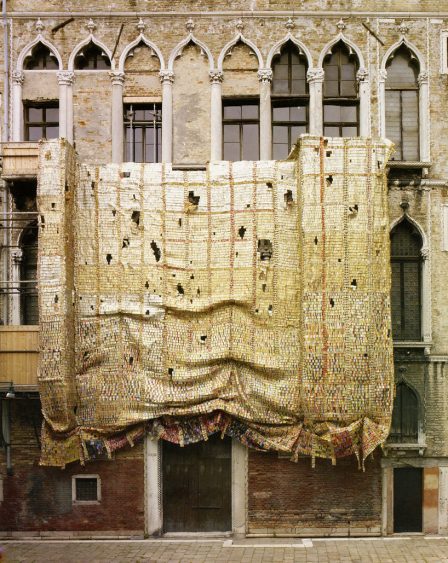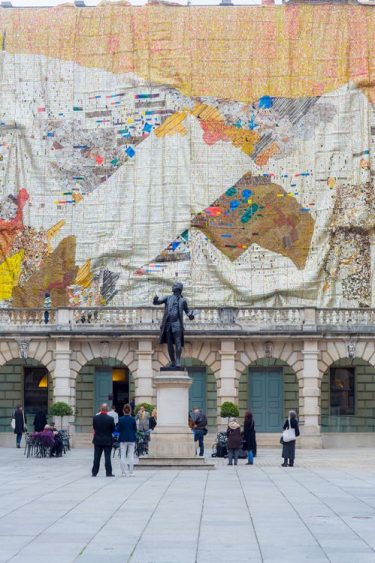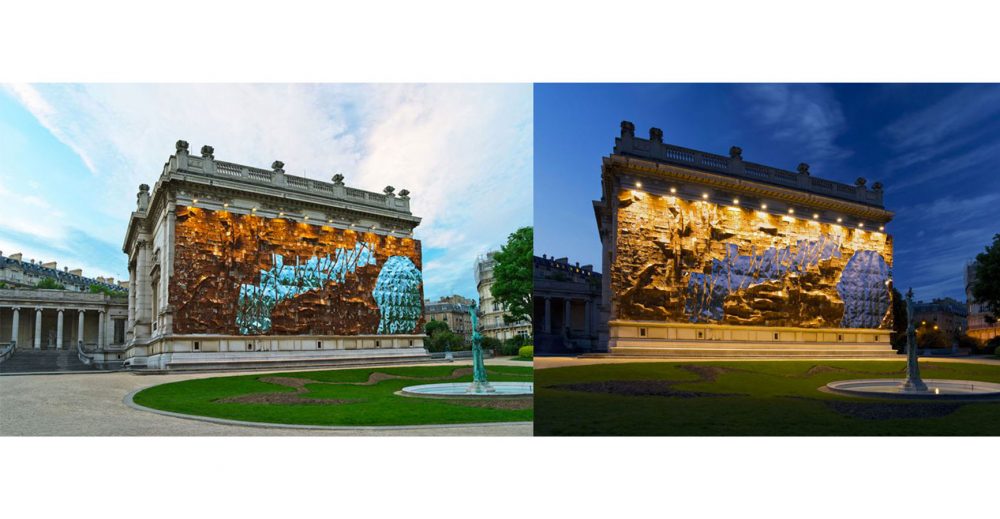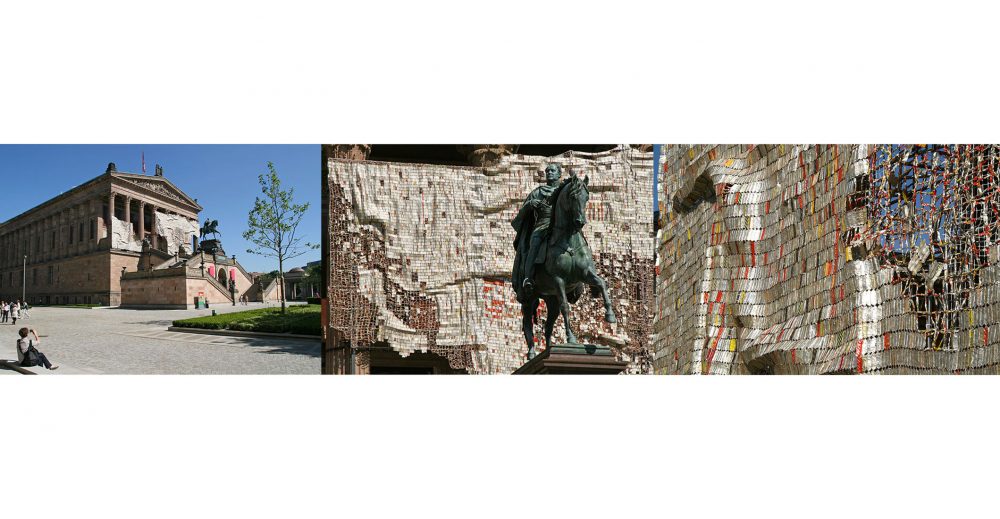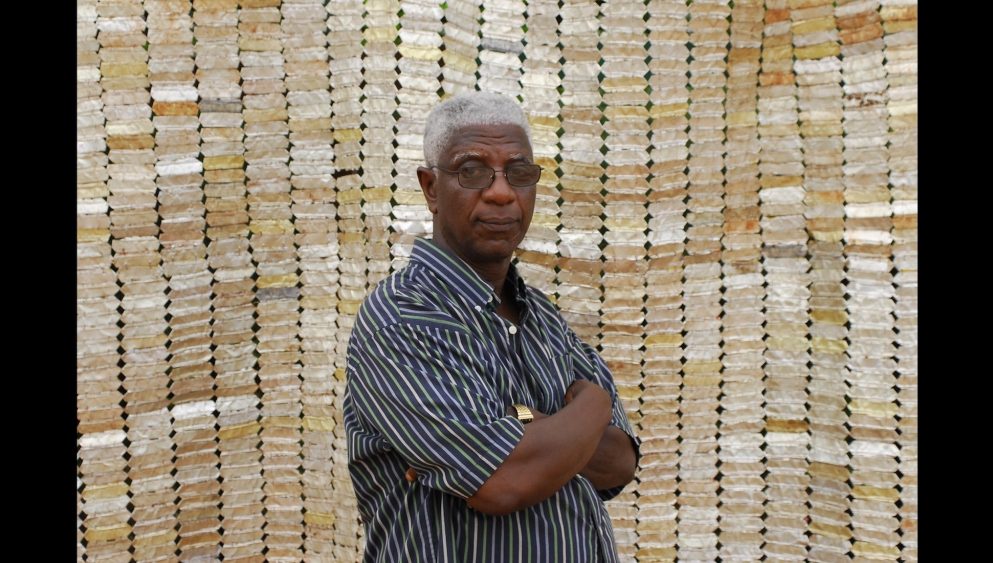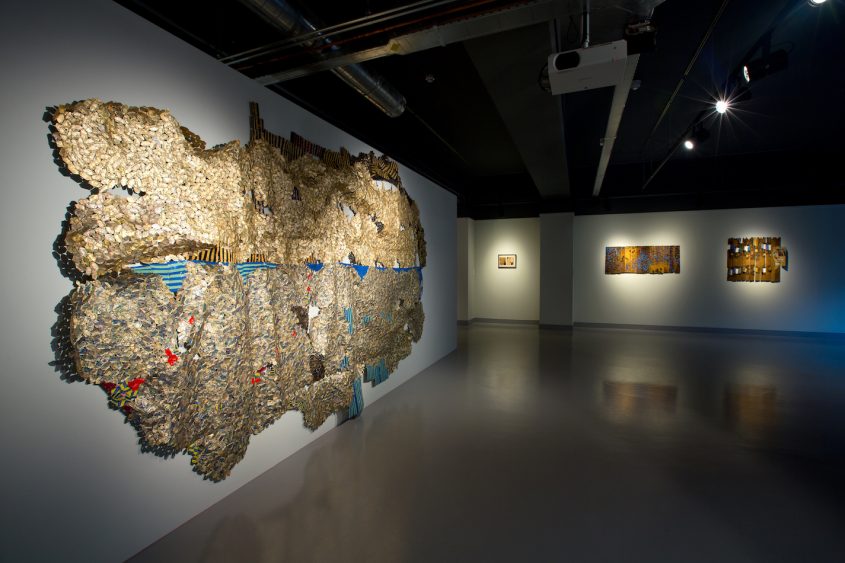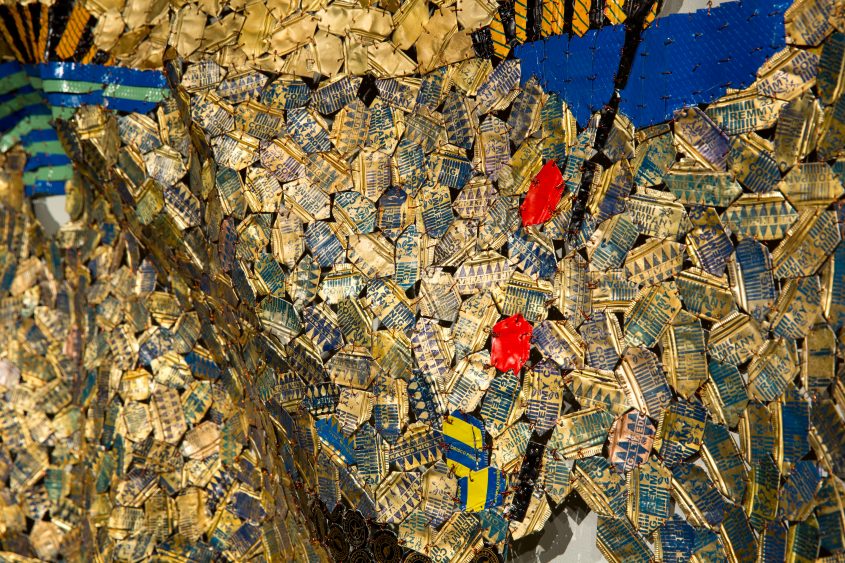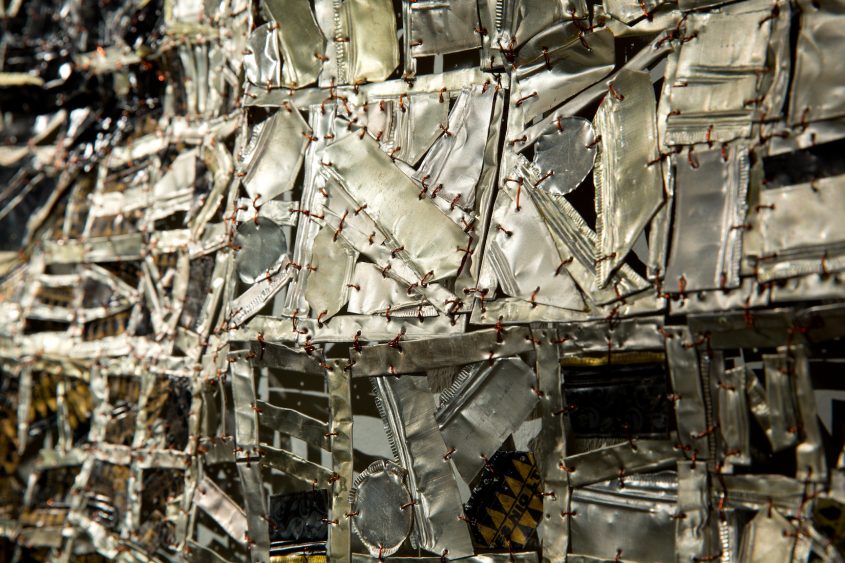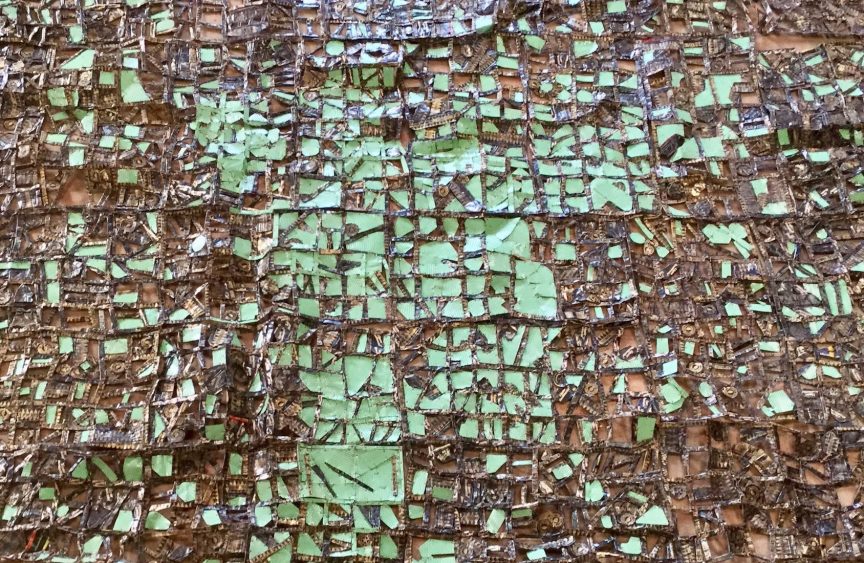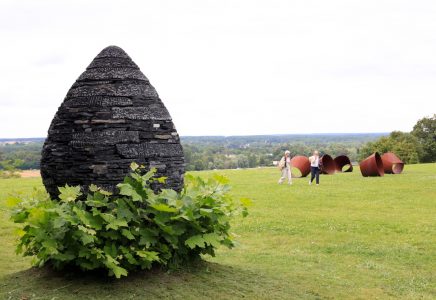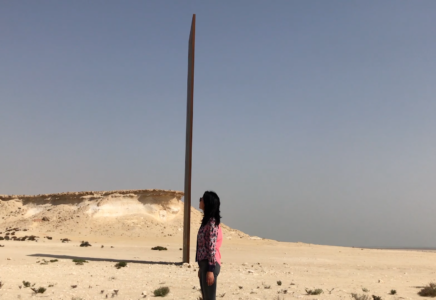Material matters: El Anatsui
People passed without noticing. But El stopped to pick up the dusty bag filled with discarded bottle tops, and turned them into gold. ‘I was looking for something ethereal. I really want to move people.’
El Anatsui (1944), known as El, is a Ghanaian sculptor belonging to the Ewe tribe, but he has spent most of his life in Nigeria, where he taught at the University of Nsukka. At 56 years old, he rose to fame by transforming thousands and thousands of bottle caps into monumental luminous structures alluding, in the shape of beauty, to global abstraction, the history of Africa, indigenous textiles, and life as a process of change. In 1990 and 2007, he participated to the Venice Biennale, cladding the walls of the Arsenale and Fortuny Palace with his dazzling sculptures. Today, curator Bisi Silva looks back on the career of the 72-year old sculptor in a biographical exhibit at the Prince Claus Fund Gallery in Amsterdam, with early works, newspaper clippings, the artist’s favorite books and music, drawings by his mentor Ucho Okeke, a film by African art expert Susan Vogel, and last but not least, some of his impressive malleable metal wall hangings. From a distance, my eyes revel in the shimmering reflection of light and the way the colored bottle tops have been ordered to create a rhythm in fields of gold. My body responds to the undulating forms and the overwhelming size. My spirit is lifted. But when I come closer, the dream of transcendence is shattered in a myriad of castaway bottle tops.
Flexibility
Imagine the patience that was required to make this! In her film Fold Crumple Crush: Art of El Anatsui (2011), African art expert Susan Vogel gives insight on the time-consuming process. For over two or three months, some forty young men from the local community are involved in cutting, hammering and folding the bottle caps. With copper thread, they join them together into flexible blocks. Then comes time for El to create his composition. After drawing lines on the floor, he continues shifting the blocks and making digital photographs to gauge the result until he is finally satisfied. ‘I am a sculptor,’ El says emphatically. But he challenges the traditional notions of sculpture as a three-dimensional and static art. You can’t bump into his work. Instead of objects, his flexible structures adapt to their surroundings, whether indoors or outdoors. Nevertheless, covering walls, buildings, hedges or trees, they don’t simply obey the laws of gravity. The undulating, sculptural folds seem to have a life of their own. For El, this physical flexibility is a metaphor for a certain mentality. ‘I believe in the element of change. Life is always in a state of flux. My artworks should reflect this. Creating a form that is free, contracting and expanding, capable of being displayed in many ways, on walls, hedges etc.’ When his work is displayed outside, El does not concern himself with the weathering of the bottlecaps, which results in heated discussions with museum directors. ‘In Venice, the work was outside for six months, and when it came back I saw that salt and wind had affected it, it had a patina of age. Now I use that, so the bottle caps are bleached in the sun. Wear and tear is welcome. As a human being, you age and change. You learn to live with that.’
Textile
His flexible metal draperies are often associated with textile. Especially with kente cloth, which consists in narrow woven strips sown together. El’s father and brother were kente weavers. Was he inspired by this sumptuous Ghanaian cloth, once designed for tribal chiefs to display their wealth? El admits that he comes from a living kente tradition, but the meaning is not limited to that, he says. Coincidently, the colour scheme of the bottle caps happens to be the same as that of kente cloth. ‘At first I was ignoring the colors of the various caps – the red, black, white, and yellow were all there. So I started being aware of them as well. Most of the time, art has a huge element of play in it. In the process, you develop a language.’
Aesthetically and in terms of meaning El seems to be driven by the properties of the material itself. ‘The caps have a strong reference to the history of Africa. Eventually, alcohol became one of the items used in the transatlantic slave trade.’
African roots
El Anatsui came of age after independence. In 1957, the former British colonies Gold Coast and Togoland were transformed in the new state of Ghana. But African art schools still had to be reformed. ‘They were offshoots of art schools in the west. We learned about the Renaissance. The curriculum was more British than Ghanaian. We felt something was missing. Which set my colleagues and me on a search for our own culture. It made us richer to know about western and African art.’
El was delighted when he discovered the indigenous Adinkra symbols, which represent concepts or aphorisms. Africa was said to have no writing traditions, but here was a form of communication through art. ‘Originally Adinkra symbols were printed on fabrics worn at funerals. They had to say something about life! On the fabric these symbols are repeated, but I isolated one and reproduced it in the middle of a wooden tray, as a way to reinforce its meaning.’
Subsequently, El invented symbols of his own. His wooden reliefs from the nineties, engraved with a rhythm of dots and lines, seem abstract. But for El, the puncturing and burning of the wooden slats and the brutal marks made with a chainsaw refer to the history of Africa and most specifically to the 1884 Berlin Conference, when colonial powers divided the continent. ‘I thought of tearing things into bits and pieces.’
Found objects
After his wood sculptures, El started to work with discarded bottle tops. El cherishes found objects, because they have been part of life. ‘If, for instance, I worked with bronze, it’s distant. People don’t relate to it. When you touch things that have been used before, they connect with you. Because they have been used by man, they have a history. The use of found objects is not new to the African continent. It was there right from the beginning. In traditional African art, materials like wood, skin, and feathers came from around them. I wanted to give this legacy to the students. Make it big, so that the viewer is dizzy. Hundreds, thousands of bottlecaps. Take it, make it your own, make it new!’
Multiple interpretations
El’s work often consists of fragments, pieced together into a whole, which also has a personal motivation. Without knowing it, El was raised by his aunt and uncle. When he discovered that they were not his parents, it came as a shock, he recalls in Susan Vogel’s film. El’s real father had thirty-two children from five different wives. El was one of those children. ‘Who was I?’ he wondered. In search of his identity, he decided to choose his own name: El Anatsui. At 29, he welcomed the invitation from Uche Okeke to teach at the University in Nsukka, Nigeria, where he still lives today. Single. ‘I use broken pieces because of my family history, because I am not living in my nuclear family and in my native country.’ El’s work often has hidden meanings, but he doesn’t want to impose them on the viewer. He prefers to leave it open to different interpretations. ‘Just like my language Ewe. It is tonal. A written word can have different pronunciations and meanings. That undetermined character makes it attractive to me.’
Meyina
Until April 28, 2017
Prince Claus Fund
Herengracht 603, 1017 CE
Amsterdam
princeclausfund.org
